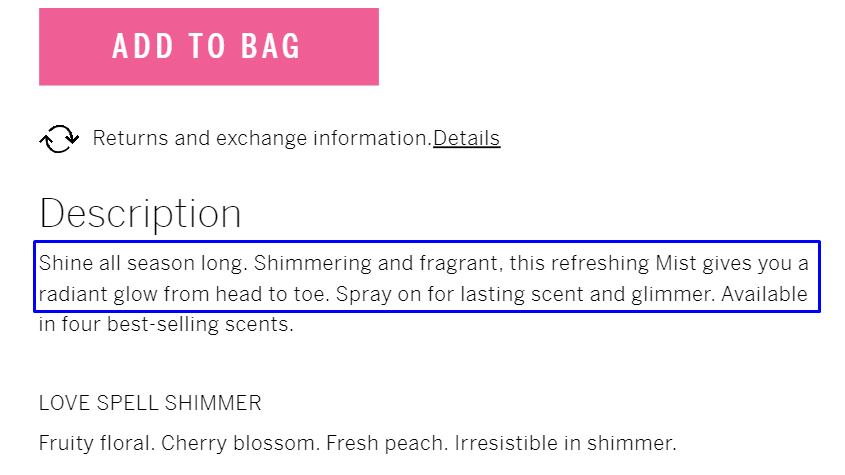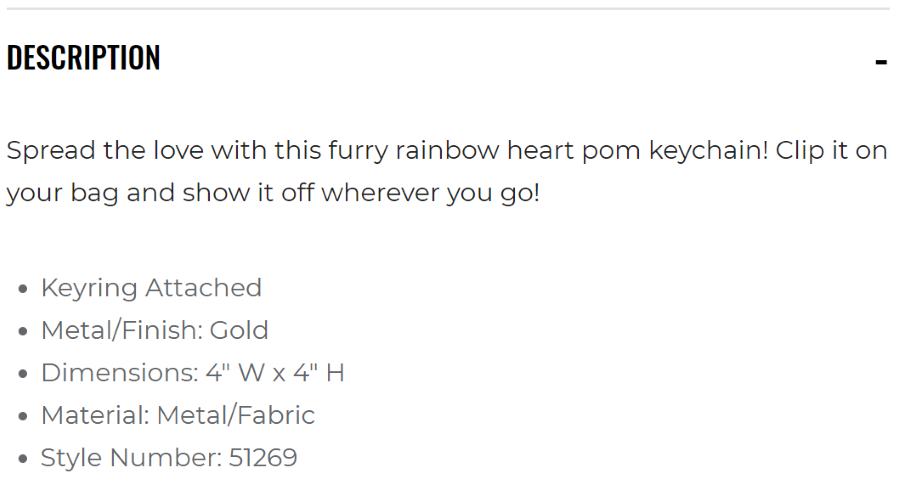Ecommerce copywriting is not an easy task. Making visitors buy your product without actually seeing, touching, and testing it was supposed to be tough.
But there are certain tactics and principles that have been proven to work. And you don’t need to be a salesperson to persuade your online store visitors to buy from you. It doesn’t even matter what you sell - a $9 picture frame or a $499 washing machine.
The tips and best practices below will guide you effectively regardless of what’s your niche market. You will learn how to write eCommerce product descriptions or at least provide informed feedback when your copywriter submits his version.
We are starting right now and with the common mistakes, many eCommerce vendors tend to make.
5 common Shopify product descriptions mistakes you should avoid
-
Including vague statements like “this product is of very high quality”, “is the best”, “is just great”
These words are so overused. In addition, they are extremely unclear and don’t describe the product properly. Provide sound reasons for what factors make your product worth paying for.
For example, instead of just saying that the shoes you sell are of high quality, also clarify the reasons. Because shoes on your store are handcrafted, made of leather, and with Goodyear Welted method.
-
Using jargon and niche-specific words that people might not understand
You may come up with a similar situation especially if you sell white goods (refrigerator, washing machine) or other technical products. But even if you run a makeup store, you shouldn’t emphasize only the ingredients of each item.
Try to explain why that technical feature (or ingredient) is important and why one should care about it.
-
Adding the manufacturer’s description, i.e. raw facts about the product
That’s true, manufacturers provide details about each product. But first, they give the same details to all vendors. And second, those details are usually just basic information about the product (colors, size, dimensions).
Here’s an example of a product description that contains only basic facts about the clothing. And nothing about what advantages they have. The online store could mention how smooth and fashionable satin is and how durable synthetic clothes are.
![product details example]()
-
Copying product descriptions from competitor store websites
“My competitor has already added good product descriptions. And I sell similar stuff. Why spend time and money to write descriptions from scratch? I can just copy them!”
A similar mindset does more harm than good for you.
The worst thing that can happen: Google will see that the copy on both sites is the same. Then, it will understand that the duplicate version is on your site, so you will get penalized.
Another thing is that your visitors will understand that your description is the same as on another site they visited. And you will miss the chance to stand out and will look like an average copycat.
-
Adding the same copy in multiple product pages
You may have only 7-8 product categories, but thousands of product items on your store. Creating a unique description for every single item can be quite challenging and require big investments.
But if you include the same text on 1+ pages, you already know what Google will do with your pages. Find the duplicate ones and penalize them.
To avoid this, you can block pages that contain duplicate copy and ask Google not to index them.
Thus, you will be able to use the same copy for multiple pages but Google won’t show blocked pages on search engine results.
So how to write eCommerce product descriptions that convert visitors into buyers?

Here are 13 principles and tactics on how to write product copy for your Shopify product descriptions:
-
Keep your ideal buyers in mind
Who are your visitors and who are likely to buy your product? Are you addressing men or women, are they young or old, why will your product make them feel better?
Knowing your buyer personas will help you understand what writing style and words to use.
Say you run an online fashion store selling sequin evening dresses. First, conduct a survey and market research to know who is likely to wear similar dresses. Women between 20 and 45 or older? What are the reasons they prefer a similar dress? What words do they use to explain their choice?
The more details you get from and about your potential customers, the better you’ll understand how to write a convincing copy.
-
Use a conversational, friendly tone
Though talking to your visitors is not the same as talking to your friends, some friendliness won’t hurt your business. The best thing you can do is to write in the 2nd person, i.e. using words like we, you, your, yours.
They directly address the visitors and make them feel more connected with you.
![headphone product description]()
Karen Finnegan, Owner at Think of the Floofs (online store selling gear for dogs), says:
![Karen Finnegan]()
“At Think of the Floofs, we aim for really light and fun product descriptions!
We try to implement more descriptive, memorable titles that make a customer remember our product. For example, one of our product descriptions starts with “Woah - check your good boy out! Stylin' and keepin' warm - a double hitter!”
Our product descriptions are helpful as well as colorful. And we always try to use language our customers will enjoy and even get a laugh out of.”
-
Focus on benefits, but don’t forget about features
Features are just facts. Benefits, results are what entice people and make them want your product. Here’s an example from Gillette:
![Gillette product copy]()
They know that the major problems men face after shaving are skin irritation and rough skin. So their main task is to tell the visitors - this cream will not result in similar issues.
The visitor can click on the INGREDIENTS (=features) tab if he’s interested in them too.
-
Optimize your copy for organic search results
You want your product pages to rank on Google for your target keywords. The best practice for eCommerce copywriting is to use your main keyword in your URL, product headline, and the body.
Depending on how long your description is, you can use the same keyword for up to 2-3 times.
Another thing you should consider is to target long-tail keywords. If your page targets the keyword “smartphone”, it will be much harder to rank. When you target specific keywords (“smartphone xiaomi redmi note 7”, “smartphone Samsung galaxy m20”), you have higher chances of ranking and driving quality traffic.
Jeff Moriarty, Marketing Manager at Moriarty’s Gem Art (online store selling jewelry), says:
![Jeff Moriarty]()
“Our product page description writing is one of the things we spend the most time on.
We normally start by using a tool such as Google Keyword Planner to find the best keywords to include in our copy. This helps us rank for more terms.”
-
Increase the readability of your text
The look of your copy is more important than what you actually write. Because people first notice the structure, skim through the text, and then read (if they decide to).
You can have the most exciting message on the planet to communicate. But if your sentences are 20+ words, your paragraphs are 10+ lines, your copy will lose its power.
Keep your sentences max 15-20 words. Use short and simple words, make your paragraphs 2-3 lines max. Include bullet lists, make your fonts bold to highlight important words.
Here’s a good example from Ikea:
![Ikea product copy]()
-
Know when to rely on short descriptions
Short descriptions can best work in 3 situations:
-
If your brand reputation is high, your visitors already trust you and don’t require many explanations about the quality.
For example, here’s a screenshot from Victoria’s Secret. It describes one of their mists in just 3 lines. Plus, they mention how the mist smells in just a few words.
![Victoria’s secret product description]()
-
If you sell a product with no technical aspects and your visitors are informed enough about it.
For example, you won’t tell your visitor what to do with a t-shirt. But you will probably talk about how much light a LED bulb gives and how effective it is for daily usage.
-
If your product is of a low-price and visitors can “risk” buying it, even without knowing deep details about it.
Potential customers usually don’t need many details and explanations for inexpensive products. Only 1-2 sentences with some features can be enough so they make a buying decision.
![keychain description]()
-
If your brand reputation is high, your visitors already trust you and don’t require many explanations about the quality.
-
Know when to rely on long descriptions
If your products are high-ticket, have technical features, and/or your brand is not so well-known, don’t hesitate to provide more information.
Let’s look at an example from an online store selling beard products.
![Beardbrand product page]()
![Beardbrand product description]()
Though the kit is inexpensive, you see how much info they provide to the visitor.
On the left side, they describe both the feeling of using this kit and mention the extra benefit it provides.
On the right side, they give details about how to use the oil, what the items are made from, etc.
Despite the amount of the text, it’s relevant, useful, and combines emotions with functionality.
The key takeaway is that long copy is OK if it doesn’t contain redundant and boring sentences. But if there isn’t much to tell about the technical features, usage, ingredients, you’d better keep it simple.
-
Paint a picture, make them feel as if they already have your product
Let’s quickly look at the example below from an online clothing store:
“...perfect for your Christmas party”.
![pretty little thing product copy]()
The writer could build a connection between the dress and the visitor, helping her imagine herself wearing it. And not just for an ordinary day but for her Christmas party.
Whatever product you sell, you can use similar formulas:
“Imagine yourself [doing smth] with [product] and feeling [adjective]”
“You can [do smth] with [product] and make your day [adjective]”
Your goal is to make the visitor feel mentally close to your product. That’s one of the most powerful answers to the question “how to write e-commerce product descriptions”.
-
Handle buyer’s objections right in your copy.
There are perfect ways to figure out what objections your prospects might have. Go to online stores where vendors sell products similar to yours. Read buyer reviews, analyze what they appreciate or dislike about that product. Check out the product’s FAQ section to know what questions people ask.
Once you have both positive and negative elements at hand, you can turn them into a copy that will leave your visitors without doubts.
-
Sometimes you’d better emphasize logic, other times - emotions.
There are products that don’t solve any major problem.
For example, a picture frame or a photo album isn’t essential for everyone. But they help people revive the best moments in their lives and put them in front of their eyes.
While advertising these kinds of products, you should appeal purely to emotions.
![album product copy]()
-
Speak your visitor’s native language.
Is your online store available only in English? If so, of 7.5 billion inhabitants out there, 1.5 billion (20%) will understand your website copy. That’s a huge number. But what about the remaining 80% who don’t know English? Any of them can be your potential customer and visit your online store.
Plus, for the vast majority of English speakers, English is not a native language. And your descriptions might be hard to understand clearly. So what to do?
First, you should analyze which countries you receive the most traffic from.
Second, you have to decide which languages are the most popular among those countries.
Your third step is to install a Shopify translation app like Gtranslate (starts at only $7.99 monthly) and make your site multilingual.
And your fourth step is to amaze your visitors with a positive experience and a caring attitude.
![GTranslate features]()
-
Mention what’s included in the purchase and what the buyer will receive.
When someone sells a camera, it can be natural to show it on a camera stand. But that doesn’t mean the camera stand is part of the deal.
If you sell gift sets with multiple products, clearly mention what items are included in it. Even in simple cases, the visitors may misunderstand you and it may result in negative reviews.
![gift box]()
-
Add features, then clarify the benefits on the same line.
For example, if you sell pet strollers, you’d like to list features like
Large protective pet compartment.
Ergonomic handle, with adjustable height.
Removable internal liner.
But they sound a bit boring and don’t address the reader. To make it better, we can just add the benefits right after the feature:
Large protective pet compartment even for the biggest dogs.
Ergonomic handle, with adjustable height, so everyone in your family can use it.
Removable internal liner so it’s easy to clean after a big day out.
Source
You will agree that the second version is more compelling and understandable for average readers.
Final thoughts
So you are already familiar with product description best practices and can start applying immediately. But here’s the question: do you have enough time to write them all or you’d better hire a copywriter?
If you hire a copywriter, one product description may cost you around $5. Agencies might charge a little bit more.
Well, even if you hire a professional writer or an agency, you still need to review their work. And since you know all the ins and outs of how to write eCommerce product descriptions, you won’t end up paying for a poorly done job.
Oppositely, if you have enough time and want to save some money, open a Google sheet and start writing.
The last thing we want to share is that A/B testing can be your best advisor. It simply means that you write two different description versions, run them for the same period separately, and see which version outperforms.
For example, you can write one short and one long description of your page. The short version runs for 3 months. Then you replace it with the longer version and it again runs for 3 months.
Analytics will show you which version works best based on the number of purchases.
Did you like our post? Let us know your thoughts or questions in the comments below.













